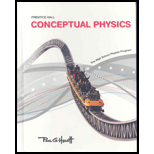
The transformers are all powered with 100 W, and all have 100 turns on the primary. The number of turns on each secondary varies as shown.
a. Rank the voltage output of the secondaries from greatest to least.
b. Rank the current in the secondaries from greatest to least.
c. Rank the power output in the secondaries from greatest to least.

a).
To arrange: the values of secondary voltage in decreasing order.
Answer to Problem 22A
The decreasing order of the secondary voltage is :
Explanation of Solution
Given:
The primary voltage for all systems,
The primary turns for all systems,
The secondary conditions for all system given below:
System A:
The secondary turns,
System B:
The secondary turns,
System C:
The secondary turns,
Concept Used:
The transformer relation is given as:
Calculation:
For system A:
The voltage produced is calculated as:
For system B:
The voltage produced is calculated as:
For system C:
The voltage produced is calculated as:
From (1) , (2) & (3) we get:
Conclusion:
The secondary voltage values greatest to least:
b).
To arrange: the reading of the current in decreasing order.
Answer to Problem 22A
The decreasing order of the current is :
Explanation of Solution
Given:
The primary voltage for all systems,
The primary turns for all systems,
The power for each system,
The secondary conditions for all system given below:
System A:
The secondary turns,
System B:
The secondary turns,
System C:
The secondary turns,
Concept Used:
The power delivered to the transformer:
Calculation:
For system A:
The current is calculated as:
For system B:
The current is calculated as:
For system C:
The current is calculated as:
From (4) , (5) & (6) we get:
Conclusion:
The current readings from greatest to least:
c).
To arrange: the output power in decreasing order.
Answer to Problem 22A
The decreasing order of the output power is :
Explanation of Solution
Introduction:
The power is defined as the rate of energy transfer.
As per energy conservation the total energy will be conserved. So the power in the primary coils is equal to the power in the secondary coils.
Conclusion:
The output power will be same in all systems.
Chapter 37 Solutions
Conceptual Physics: The High School Physics Program
Additional Science Textbook Solutions
College Physics
College Physics: A Strategic Approach (4th Edition)
Physics (5th Edition)
Tutorials in Introductory Physics
Lecture- Tutorials for Introductory Astronomy
Life in the Universe (4th Edition)
 College PhysicsPhysicsISBN:9781305952300Author:Raymond A. Serway, Chris VuillePublisher:Cengage Learning
College PhysicsPhysicsISBN:9781305952300Author:Raymond A. Serway, Chris VuillePublisher:Cengage Learning University Physics (14th Edition)PhysicsISBN:9780133969290Author:Hugh D. Young, Roger A. FreedmanPublisher:PEARSON
University Physics (14th Edition)PhysicsISBN:9780133969290Author:Hugh D. Young, Roger A. FreedmanPublisher:PEARSON Introduction To Quantum MechanicsPhysicsISBN:9781107189638Author:Griffiths, David J., Schroeter, Darrell F.Publisher:Cambridge University Press
Introduction To Quantum MechanicsPhysicsISBN:9781107189638Author:Griffiths, David J., Schroeter, Darrell F.Publisher:Cambridge University Press Physics for Scientists and EngineersPhysicsISBN:9781337553278Author:Raymond A. Serway, John W. JewettPublisher:Cengage Learning
Physics for Scientists and EngineersPhysicsISBN:9781337553278Author:Raymond A. Serway, John W. JewettPublisher:Cengage Learning Lecture- Tutorials for Introductory AstronomyPhysicsISBN:9780321820464Author:Edward E. Prather, Tim P. Slater, Jeff P. Adams, Gina BrissendenPublisher:Addison-Wesley
Lecture- Tutorials for Introductory AstronomyPhysicsISBN:9780321820464Author:Edward E. Prather, Tim P. Slater, Jeff P. Adams, Gina BrissendenPublisher:Addison-Wesley College Physics: A Strategic Approach (4th Editio...PhysicsISBN:9780134609034Author:Randall D. Knight (Professor Emeritus), Brian Jones, Stuart FieldPublisher:PEARSON
College Physics: A Strategic Approach (4th Editio...PhysicsISBN:9780134609034Author:Randall D. Knight (Professor Emeritus), Brian Jones, Stuart FieldPublisher:PEARSON





